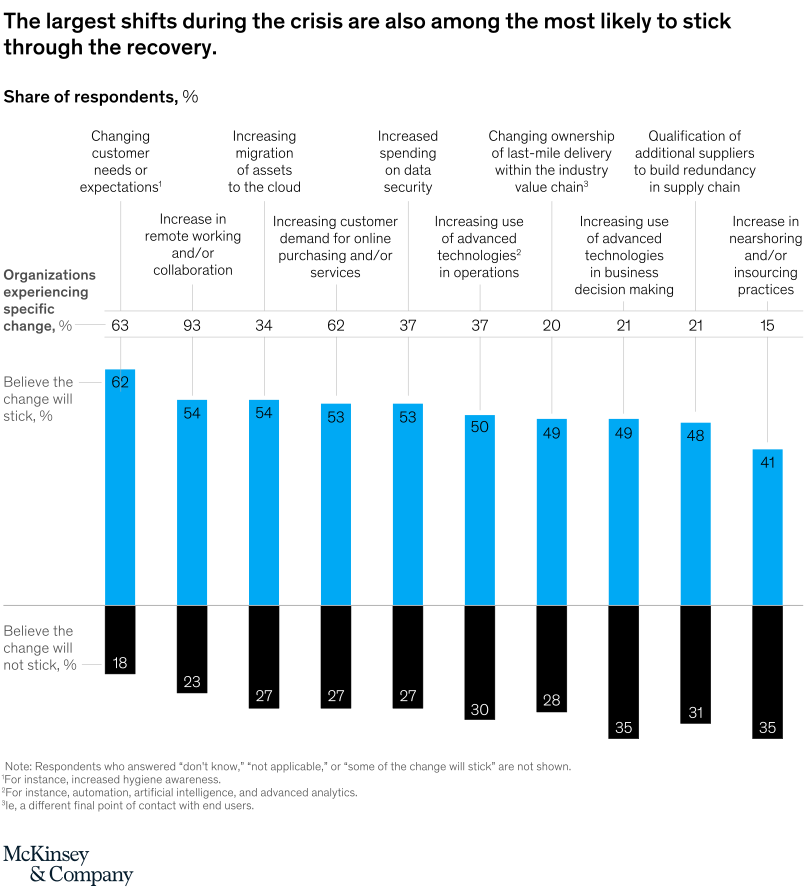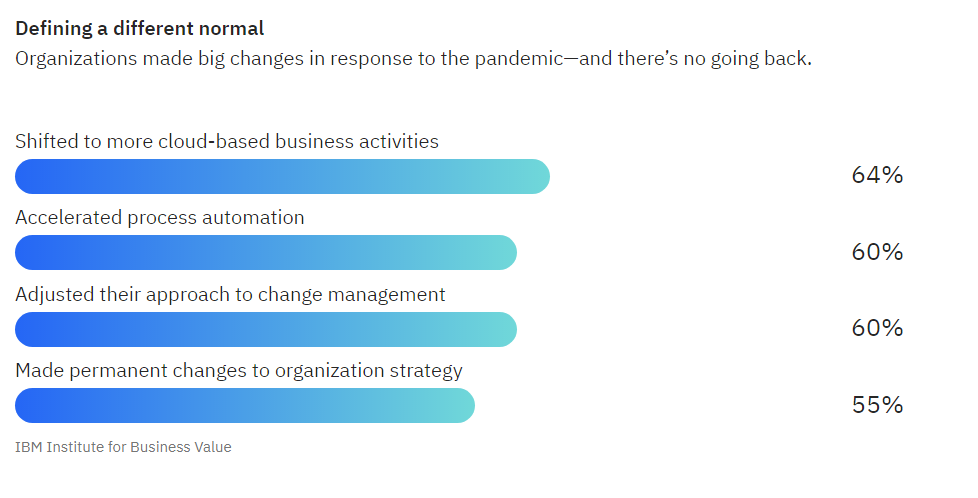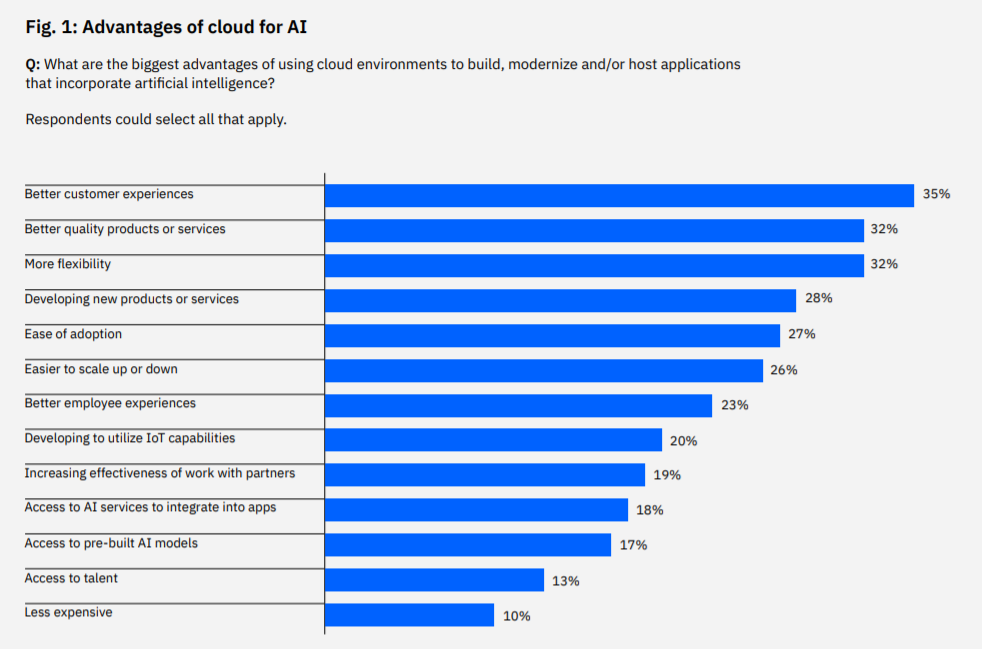A CEO’s guide to migrating data and workflows to the cloud in 2021, Tips on what Mistakes to Avoid
For businesses to win in 2021 and beyond they will need to continue to invest in diverse talent, data, AI, and digital cloud technologies to compete in the new remote hybrid work office world.
The Covid-19 pandemic over the past 15 months has changed consumer behaviors, business models, how people collaborate and work together —requiring organizations to rethink their teams, processes, and technologies to stay competitive. If your company isn’t already transforming digitally, now is the time. Digital transformation is not a product or a solution. It’s a continuous process involving new technologies and ways of working to compete successfully through continued innovation. It must encompass technology, culture, and processes—in concert with one another.
Organizations that rapidly provide new digital services have advantages over those stuck in the past. But many leaders don’t know where to start. Digital Transformation with the cloud.
A recent article published in the Harvard Business Review by Bhaskar Ghosh and Karthik Narain titled “What CEOs Need to Know About the Cloud in 2021” that the cloud is closely tied to five key areas all CEOs must lead:
- Speed to market
- Reduced costs
- Flexibility of operations
- Business resilience
- Innovation capabilities
But business leaders have concerns about moving completely to the cloud – with reason.
There have been some organizations that have rushed to migrate their systems to cloud technologies and have found themselves getting things wrong the first time – and finding cloud costs running higher than expected and wasting a lot of money, time and effort.
While organizations’ (both large and small) shift to the cloud has been slow over the last decade, a recent Accenture Cloud Outcome 2020 Research report shows that the Covid-19 pandemic created a new inflection point and has sped up cloud migration to enable end-to-end digital transformation. The HBR article points out that “in 2020, companies of all kinds quickly learned that they had to depend on cloud technologies to enable entire departments to work remotely from home, to ramp up digital commerce, and to provide telehealth, entertainment streaming, and more.”
But just because cloud migration is crucial to compete in our ever growing digitally enabled economy doesn’t mean it’s easy to implement. In fact the Accenture report (which surveyed over 750 C-suite leaders) lays out that the journey to reaching the cloud’s transformational benefits are complex – involving multiple dimensions including rethinking strategy, technology, skills development, business processes as well as organizational design.
The Role Cloud Computing had with Covid-19 Drug Vaccine Developments
The authors of the HBR article point out that the scientific breakthrough, over the past year with multiple pharmaceutical drug companies developing vaccines to fight Covid-19 would not have been possible without the utilization of cloud computing technologies. They highlight the biotech company called Moderna, (which is a much smaller and relatively unknown compared to Pfizer and J&J,) was able to scale its operations on the cloud using Amazon’s AWS as its preferred cloud provider, as well as its standard for analytics and machine learning workloads. By leveraging its proprietary cloud-based technologies and methods to create it’s mRNA platform and manufacturing facility with the AWS-powered research engine, Moderna delivered the first clinical batch of its vaccine to the NIH for the Phase 1 trial 42 days after the initial sequencing of the virus.
Moderna also uses the cloud to quickly design research experiments and uncover new insights, automate its laboratory and manufacturing processes to enhance its drug discovery pipeline and easily shift between vaccines for different viruses without investing in new technology or infrastructure.
Cloud technology providers (Microsoft, Google, IBM, Amazon) are giving startups and mid sized companies access to big tech capabilities — compute power, algorithms, programming tools, and architectures — and partner in an ecosystem with larger firms.
COVID-19 pandemic has created an urgent need for organizations to accelerate their digitization efforts and a shift to cloud based business activities
The Coronavirus pandemic has changed consumer behaviors, business models, how people collaborate and work together and it has accelerated the adoption of the digital economy to a level that is creating winners and losers in many industries.

(image credit: Mckinsey & CO)
Today, more than ever, companies need to operate and compete at an unprecedented speed and scale as industries are reshaping beneath them. This means innovating faster, creating new revenue streams, deriving more insights from data – and from the edge – and interacting differently with their customers, partners and employees. All of these changes are important, inter-connected and require a framework to drive them and that is Cloud infrastructure.
But according to data from the Accenture Cloud Outcomes report “prior to 2020, progress toward the cloud had actually been quite gradual. As we found in designing the research for our recent survey of 750 C-level leaders, today, about 20% to 30% of work is being done through the cloud, and companies initially planned to accelerate that to more like 80% over an eight- to 10-year process.” The HBR article author Bhaskar Ghosh, Chief Strategy Officer of Accenture explained that “since the virus hit, companies of all kinds quickly learned that they had to depend on cloud technologies to enable their entire staff to work from home, to ramp up digital commerce, and to provide telehealth, entertainment streaming, and more. We now see this shift to 80% taking place in the next three years.” and these findings are not from just one organization.
According to new research from an IBM Institute for Business Value report “Covid-19 and future of business” found that The COVID-19 pandemic has accelerated digital transformation at 59% of surveyed organizations. According to the executives surveyed, before the pandemic, many organizations seemingly distrusted their own technological capabilities and doubted the skills of their own workforces. But as companies were forced to move employees remote and use tech tools, many found that those fears proved largely unfounded. What they found was the reliance on tech platforms became more acute, and those platforms—along with the corporate teams who use them—delivered real results.
The COVID-19 pandemic has forever altered how organizations around the world operate. Some 55 percent of respondents say the pandemic has resulted in “permanent changes to our organizational strategy”. An even larger 60 percent say COVID-19 has “accelerated process automation,” with 64 percent acknowledging a “shift to more cloud-based business activities.”
 Company IT, Data Infrastructure & the Cloud
Company IT, Data Infrastructure & the Cloud
According to Mckinsey & Co, nowadays, CIOs and other executives are faced with a number of questions about their IT and data hosting infrastructure:
- Are we unlocking innovation for the business?
- Are we meeting business needs?
- Are we as efficient as we can be?
Companies like Mckinsey help organizations transform their IT Infrastructure through hosting modernization (such as hybrid cloud and data center co-location), automation and process streamlining, talent and capability development, and next-generation sourcing.
Getting real value from migrating hosting and data infrastructures to the cloud
Most large enterprises know they don’t belong in the data center business and they can realize significant cost savings by using new architectures or applications in the cloud. In an article by Accenture titled “How to migrate to the cloud”
- Cloud value is an essential requirement for digital transformation. Migrating enterprise workloads to the cloud is the first step.
- Successful migrations improve the efficiency and resilience of IT systems and enable the business to do new things—and to do them faster.
- A migration that balances quality and speed requires a plan that is aligned to the business strategy, and that plan must prioritize based on value.
- A secure transition requires leveraging experienced partners and industrialized capabilities, addressing security, and developing skills for success.
Cloud adoption is not simply about reducing cost—its real value comes from increased business agility, resiliency, developer productivity, and access to higher order services from cloud service providers.
There are consulting firms that help organizations unlock the cloud’s full potential by driving end-to-end cloud transformations. Enterprise companies should build a business-backed view of the future state of hosting data models, select a platform and architecture, implement an operating model, build cloud and security capabilities, coach and train internal resources, and ensure they are capturing the full value of the transformation.
What are the challenges of cloud migration?
Even with proper planning, security gaps, configuration errors or runaway costs can easily derail a cloud strategy. These are the cloud migration challenges your company will need to manage during this process:
- Legacy applications (and what to do with them) – Not every app can move easily. Which do you keep, and which do you wreck and rebuild?
- Application modernization – What are your options for rebuilding applications, so they perform optimally in the cloud?
- Cloud management – Once you have moved your applications, what’s the best way—and who are the best people— to manage them?
- Complexity of migrating – Understand the complexity you’ll face when migrating and appropriately estimate the effort to get it done.
- Key dependencies – Resolve key infrastructure and application dependencies, by prioritizing applications and identifying necessary remediation helping you to reduce risk, time and cost.
- Business support – Buy-in from stakeholders across the business is essential for migrating at scale.
What does a successful cloud migration look like?
In order to accelerate the value you get from the cloud, you must know where your business is headed—and why.
One primary goal is improving the efficiency and resilience of IT systems. As I mentioned earlier that most large organizations are beginning to understand that they should look to get out of running on expensive on-premise data centers and they can realize significant cost savings by using new architectures or applications in the cloud.
Cloud migration is the process of moving a company’s digital assets, apps, data, services, databases, IT resources, and applications either partially, or wholly, into the cloud. Cloud migration is also about moving from one cloud to another.
A second key goal is enabling the business to do new things and do them faster. This is where the innovation, experimentation and business agility of the cloud come to the fore.
Be smart about priorities. It’s important to stratify and prioritize the portfolio in a way that realizes the most value from the migration as quickly as possible.
Don’t forget the data. It’s also essential to consider each application and the data it uses as a bundle. In order to shift data “centers of gravity” to the cloud, enterprises must:
- Establish a strategic data architecture to ensure that data is available to all consumers.
- Institute data management to ensure the data is robust, high-quality, traceable, and trusted by the business.
- Develop an enterprise data governance program to ensure the business owns the data and can leverage it appropriately.
Get the business on board. Migration cannot be a purely IT-driven exercise. Most of the pitfalls encountered in cloud migrations occur when IT and the business aren’t on the same page.
Can an organization really trust its data in the cloud?
The HBR article points out that there are two key aspects to understand. First, cloud providers operate comprehensive data security programs so you don’t have to. On-premises infrastructure is prone to the kind of small mistakes that determined cyber-attackers can exploit. The main public cloud providers, however, are able to provide advanced data security controls, including data encryption, database monitoring, and access control.
Obviously, with all the hacking stories in the news, security will continue to be a valid concern, and certain companies would refrain from putting sensitive consumer or healthcare data in the public cloud. Some companies are addressing the desire to work through the cloud without exposing certain data to risk of exposure by turning to a hybrid model of public and private cloud operations. The latter allows businesses to maintain control over their most sensitive information. A hybrid cloud delivers: the scalability and reliability of public cloud with the security and customization of private cloud. A recent IBM report stated that “a hybrid cloud approach helps enterprises quickly pivot their IT resources to match shifts in business strategy. It also sets an ideal foundation to harness artificial intelligence (AI) and data analytics.”
How does a company make the right cloud choices for their business?
An article from IBM breaks down that there are three major cloud capabilities and service model solutions:
- Software as a service (SaaS) – a service provider delivers software and applications through the internet. Users subscribe to the software and access it via the web or vendor APIs.
- Infrastructure as a service (IaaS) – a vendor provides clients pay-as-you-go access to storage, networking, servers, and other computing resources in the cloud.
- Platform as a service (PaaS) – a service provider offers access to a cloud-based environment in which users can build and deliver applications. The provider supplies underlying infrastructure.
The SaaS model is what kicked off the cloud revolution. Companies could roll it out quickly, allocate resources from business budgets, and standardize processes while also enabling innovation. In 2015 a cloud-based human resource management software provider, Workday, helped Rolls Royce roll out and deploy a cloud-based HR system covering employees across 46 countries using a SaaS solution. Before making this move, the company faced challenges getting an accurate view of its workforce and deploying the right people to the right places.
As cloud computing matured, IaaS and PaaS models emerged, giving businesses a higher level of control over the alignment of business and IT objectives. PaaS provides a platform with tools to test, develop, and host applications in the same environment.
With IaaS, the Infrastructure is scalable depending on processing and storage needs.
The Pros and Cons of each Cloud Model
The HBR article authors explain that organizations need to educate themselves about the capabilities and strengths of each model and apply them wisely to facilitate business innovation and growth. Their takeaways on the models are:
- SaaS, the most commonly used cloud application service, is an important means for organizations to access software applications
- IaaS is a simple way to access computing and data storage resources, with IaaS model, a company rents servers and storage in the cloud rather than purchasing and maintaining its own infrastructure
- PaaS is a popular choice for businesses that want to create unique applications without making major financial investments
How can a business that moves their data and workflows to the cloud enable digital innovation?
Cloud is not simply a source of cheaper and better IT infrastructure. It’s also the primary enabler of business reinvention today. Why? Because it brings together everything you need to innovate—your data, your people, your partners, your processes, your technology—on one streamlined platform.
Deloitte Insights published a Cloud Migration Trends and Forecast that found when viewed at a total company level, very few infrastructure IT systems will be only on-premise, only public cloud, or only private cloud. The report found “most deployments will likely use a combination of a public cloud and a private environment that remain distinct entities but are bound together, an approach known as hybrid cloud.”
Many companies with rigid legacy systems, siloed data, old economy workforce skills and outdated operating models can’t compete with digital-first companies with emerging technologies that scale quickly, can be consumed on demand and enable data-driven business decisions. If companies want to keep up with digital disruptors, they must redefine IT and its partnership with the business.
In recent months, companies have been migrating their services and data to the cloud as they adapt to become elastic digital workplaces to deal with an increase in online demand and remote working. For businesses that have already begun the move to cloud computing, they’re accelerating a cloud transformation that will lead the way forward in the years to come. Key opportunities for reinvention in the cloud include data and machine learning, edge computing and collaborative innovation.
Some of things you can do with the cloud include:
- Modernize Legacy Applications
- Machine Learning
- Build New Business Channels using APIs
- Cloud Native Application Development
- Data Warehouse Modernization
- Work Transformation
- Mobile application development
- Improve software delivery pipeline
- Asset tracking
- Remote monitoring
There are companies using the cloud to gather oceans of data, developing analytic models and leveraging machine learning to create insights that they couldn’t have achieved before.
Recently Oxford Economics and IBM conducted a study in which they asked 6,000 CIOs, CTOs, and senior IT leaders in 6 industries (from organizations that are using cloud services in some capacity and at least experimenting with AI) about the importance of cloud architecture and AI in enabling their businesses to adapt and thrive. One high level trend that emerged from the data was that those taking a strategic approach to adopting cloud were outperforming their peers in key metrics. The analysis of the survey data, which covered six industries and 26 countries, shows that data strategies, AI and cloud—especially hybrid cloud architecture— are increasingly effective and intertwined. Because in a hybrid cloud all of your organizations data can be sourced and managed from any cloud while limiting risk from migrating, loss, or downtime.
Key findings from the study include:
- Cloud is becoming a foundational technology for the emerging AI era. Modernizing the business, automating decisions and workflows, and improving customer experiences are top motivators for AI adoption.
- AI depends on data, and that data is increasingly complex. For 77% of respondents, a unified platform for cloud, data, and AI is seen as critical to long-term success, and a similar number say cloud is a critical foundation for data management and AI
- An integrated strategy for cloud and AI can deliver benefits in several different areas. Participants were asked to name the biggest advantages of using cloud to build, modernize, and host applications that incorporate artificial intelligence, key areas included external business drivers such as better customer experiences, better-quality products or services, and more flexibility

A Salesforce article explains that Cloud computing offers modern businesses advantages, including allowing multiple users to view data in real-time and share projects effortlessly. Cloud software and SaaS applications (software as a service platforms) make working as a synchronized team easier and more accessible than ever.
People turn to data for the insights that boost their business, optimize operations and help them make smarter decisions. With a cloud-based data warehouse, you have a simple, fast and cost-effective way to access the data (and make the insights) that drive your business forward.
That means the more data you can collect, analyze and act on, the better. Cloud platforms allow you to build you a data warehouse that pulls from your most informative data sources and a dashboard that collects it all in real time. Plus, with automatic scaling, there’s no hardware required—just accurate data for actionable insights.
In the past, people would run applications or programs from software downloaded on a physical computer or server in their building. Now, with cloud computing, there’s no need to bother with inconvenient downloads.
When you check your bank balance on your phone you are using the cloud. Chances are you are relying on cloud computing already to solve the challenges faced by small businesses, whether you’re firing off emails on the move or using a bunch of apps to help you manage your workload.
Some of the other benefits of migrating to the cloud include:
- Increased agility and flexibility
- Ability to innovate faster
- Easing of increasing resource demands
- Better managing of increased customer expectations
- Reduction in costs
- Deliver immediate business results
- Simplify IT
- Shift to everything as-a-service
- Better consumption management
- Cloud scalability
- Improved performance
Does my organization have the right tech talent and skills needed to take advantage of the cloud?
The HBR article authors final thoughts include “when it comes to accelerating cloud initiatives, what’s keeping CEOs up at night the most is probably a lack of skills in the organization. For companies that have been low adopters (those doing less than 30% of their work in the cloud), almost half of CEOs cited a lack of the needed skills as a barrier to success. But even for high adopters (companies doing 75% or more of their work in the cloud), three in 10 CEOs are concerned about skills shortages.”
A company called Takeda’s announced a new cloud-driven business transformation that has lofty goals for accelerating innovation and how its people work. They’re anticipating that this shift will create hundreds of new jobs in specialized roles, turning to new talent pools, and building the skills of thousands of employees so they can accelerate Takeda’s data and digital capabilities. A cost-effective way to eliminate skills gaps is to train existing staff. This type of investment also lets employees know that their employer supports their professional development. To find the cloud skills they need, companies are increasingly turning to industry-recognized certifications: So a lower-investment approach could be to encourage your people to seek out online instruction courses such those offered through Coursera to retrain and upskill themselves. Google’s Cloud Platform also offers a number of courses and levels of certifications for specific roles such as a “Professional Cloud Architect”, “Collaboration Engineer”, “Cloud Developer” etc.
Make sure to give them time for this work and the assurance that you’ll recognize the credentials.
Conclusion
Leadership starts from the top, and for the company to have success ultimately the CEO must be involved in the cloud journey. Cloud is too important to a business’s fundamental competitiveness to be treated as an IT program. It’s about creating a platform for efficiency, innovation, and growth that will determine the future success of your business. The future of your business hinges on adopting and adapting to changing technology innovations. And for companies to remain competitive, it’s essential to be able to pivot in new market conditions and quickly align resources with needs.









